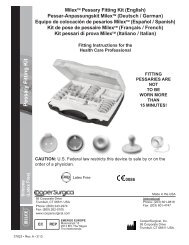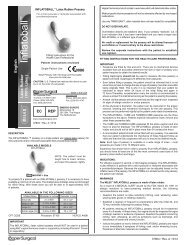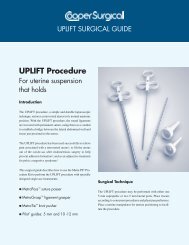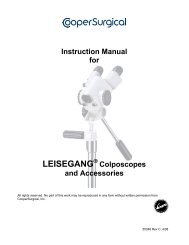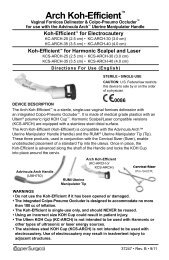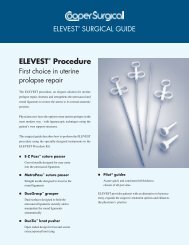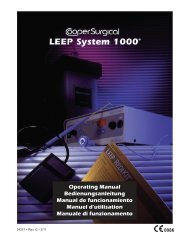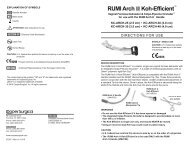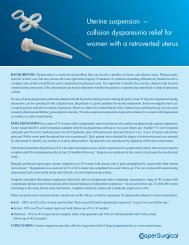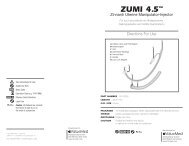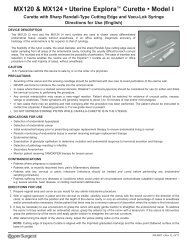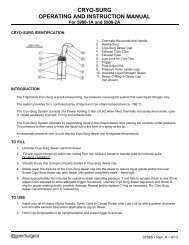LEEP System 1000® Workstation Operating ... - CooperSurgical
LEEP System 1000® Workstation Operating ... - CooperSurgical
LEEP System 1000® Workstation Operating ... - CooperSurgical
You also want an ePaper? Increase the reach of your titles
YUMPU automatically turns print PDFs into web optimized ePapers that Google loves.
2.5 Connecting the Smoke Evacuator and <strong>LEEP</strong> <strong>System</strong> 1000 ® Electrosurgical Generator<br />
together and to the Wall Outlet<br />
1. Plug in the cord running from the Electrosurgical Generator to the receptacle at the back of the<br />
Smoke Evacuator [refer to (A) in Figure 1].<br />
2. Make sure both On/Off Switches on the Electrosurgical Generator panel are in the OFF position.<br />
Refer to 1 and 12 in Figure 2. Next, attach the power cord to the receptacle at the back of the Electrosurgical<br />
Generator and then into a hospital-grade grounded wall outlet to obtain power [refer to (B) in Figure 1].<br />
2.6 Installing the Foot Pedal Switch on the <strong>LEEP</strong> <strong>System</strong> 1000 Electrosurgical Generator<br />
Connect the Foot Pedal Switch to the socket 2 , shown in Figure 2, without activating the Foot Pedal, and<br />
tighten the threaded plug. This is an air (pneumatic) operated control. There is no electric current, offering<br />
maximum safety.<br />
5 6 7 10<br />
1 2<br />
8<br />
9<br />
3<br />
4<br />
11<br />
12<br />
Figure 2<br />
2.7 Installing the Electrodes and Dispersive Patient Plate<br />
2.7.1 Placement of the Electrode<br />
• Connect the active Electrode Handpiece to the socket 3<br />
electrode of choice in the Handpiece.<br />
, shown in Figure 2, and tighten the<br />
2.7.2 Placement of the Patient Plate or Dispersive Electrode<br />
When using an electrosurgical system, it is very important that all the current delivered to the<br />
patient returns correctly to the Electrosurgical Generator via the Dispersive Patient Plate only.<br />
• Connect Dispersive Patient Plate to the socket 4 . Refer to Figure 2.<br />
• The patient must be positioned correctly on the operating table. The patient and operator must<br />
not come in contact with any metal conductive surfaces.<br />
• The Patient Plate must securely contact a vascular area close to the operating site. For a<br />
gynecology procedure the preferred sites are the patient's thigh (disposable adhesive pads) or<br />
under the patient's buttocks (reusable metal plate). The contact area must be clean, free of<br />
body lotions, shaved, and massaged for good circulation. The contact area of the Patient Plate<br />
must be maximized and frequently checked for uniform contact during the procedure, especially<br />
if the patient has moved or if liquids have contacted the Patient Plate. A CONDUCTIVE GEL IS<br />
RECOMMENDED. The Patient Plate MUST NEVER be placed so as to allow the patient's heart<br />
to be in the pathway from the active electrode.<br />
• Power delivery to the operative site may be decreased appreciably if alternate pathways exist;<br />
for example, through the metal operating table, crossed Handpiece/Patient Plate Cables, etc.<br />
<strong>LEEP</strong> <strong>System</strong> 1000 ® <strong>Workstation</strong> • <strong>Operating</strong> Manual<br />
5



